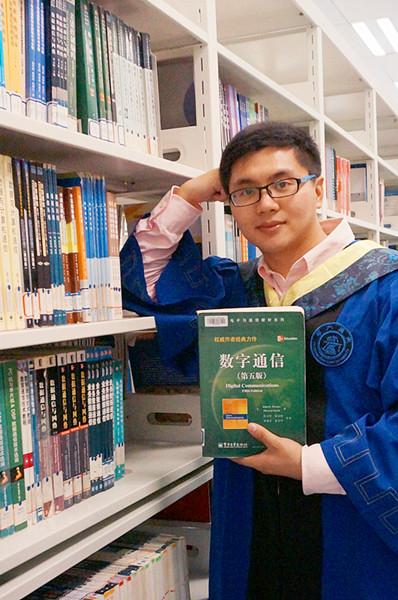Recently, a master’s thesis titled “Random Analog Network Coding: From Design to Applications” by Wenguang Mao, a former University of Michigan- Shanghai Jiao Tong University Joint Institute (UM-SJTU JI) graduate student, has been awarded 2015 Shanghai Outstanding Graduate Thesis Award.
 On the winning, Mao thanked the patient guidance of his adviser, Professor Xudong Wang who helped him get through a number of obstacles. Professor Wang emphasizes research and innovation as well as a full range of capability training, which laid a solid foundation for Mao’s later research work and has had a positive impact on his career planning.
On the winning, Mao thanked the patient guidance of his adviser, Professor Xudong Wang who helped him get through a number of obstacles. Professor Wang emphasizes research and innovation as well as a full range of capability training, which laid a solid foundation for Mao’s later research work and has had a positive impact on his career planning.
During his master study, Wenguang Mao mainly focused on the design and application of analog network coding (ANC). As one of the most promising physical-layer techniques for the next-generation wireless networks, ANC can dramatically enhance network throughput. However, applications of ANC to real networks are very limited due to the restriction of frame-level synchronization. To resolve this challenging issue, Mao developed a new ANC scheme called random analog network coding (RANC), under the guidance of Professor Wang. In RANC, the decoding procedure is totally re-designed via several novel signal processing mechanisms, including joint channel estimation, waveform recovery, circular channel estimation and frequency offset compensation. RANC eliminates restrictions on superimposed frames and thus enables random concurrent transmissions among communication nodes. As a result, RANC can be easily applied to various setups of real networks.
By leveraging RANC, Mao designed a new medium access control (MAC) protocol called ANC-ERA to support scalable mesh/ad hoc networking based on ANC. ANC-ERA achieves efficient random access of ANC-enabled communication nodes without relying on sophisticated scheduling and network optimization. It also supports flexible ANC cooperations among different traffic flows and thus adapts to dynamic traffic patterns in the network. ANC-ERA makes the application of ANC fully scalable to large scale wireless mesh or ad hoc networks.
By leveraging RANC, Mao designed a new medium access control (MAC) protocol called ANC-ERA to support scalable mesh/ad hoc networking based on ANC. ANC-ERA achieves efficient random access of ANC-enabled communication nodes without relying on sophisticated scheduling and network optimization. It also supports flexible ANC cooperations among different traffic flows and thus adapts to dynamic traffic patterns in the network. ANC-ERA makes the application of ANC fully scalable to large scale wireless mesh or ad hoc networks.





